Context matters: A conversation with Elisa van Joolen and Anouk Beckers
We are so invested, many of us, in the idea of ownership. I came up with this design, so it is mine; I paid for this bag, so I own it. Upon this foundation, capitalism is built: we buy and we sell, we own and disown, and goods circulate from one owner to the next. But what does it mean, really, to own something? Can something ever really be ours? Might there be other ways, besides individual ownership, to relate to objects? And if so, what would that mean for our systems of production and consumption?
These questions are at the heart of the work of Anouk Beckers and Elisa van Joolen, who are both Rietveld graduates and who now teach at GRA as well, Van Joolen in the Basic Year and Beckers as a guest-teacher. They are designers of objects but even more so of critique: their work challenges traditional notions of ownership, authorship, originality, and value. They’re designers, as well, of processes: their projects examine alternative systems, or infrastructures, for the relationship between people and goods. After all, the downsides of our current system are becoming increasingly clear: as we accumulate more and more new things, both people and the planet are being exploited, sometimes beyond repair.
On a rainy Tuesday afternoon this Summer, we met up in Van Joolen’s studio to talk about their most recent projects, ownership and criticism, and the importance, both in their designs and in their practice, of collaboration and participation.
Van Joolen’s studio still carried traces of her most recent project, EVJ, which launched in May of 2021 at Het Nieuwe Instituut in Rotterdam. EVJ consists of 300 bags, handmade by Van Joolen and Beckers who spent hours pressing ordinary plastic shopping bags together under a heat press. The resulting hybrid bags are not for sale; people can borrow them, and when they pick a bag, either at Het Nieuwe Instituut or on evjbags.com, they have to sign an agreement saying they’ll take good care of it and return it after a fixed time. In this way, users become caretakers rather than owners of an object, forcing them to relate in a new way to an otherwise ordinary object of use.
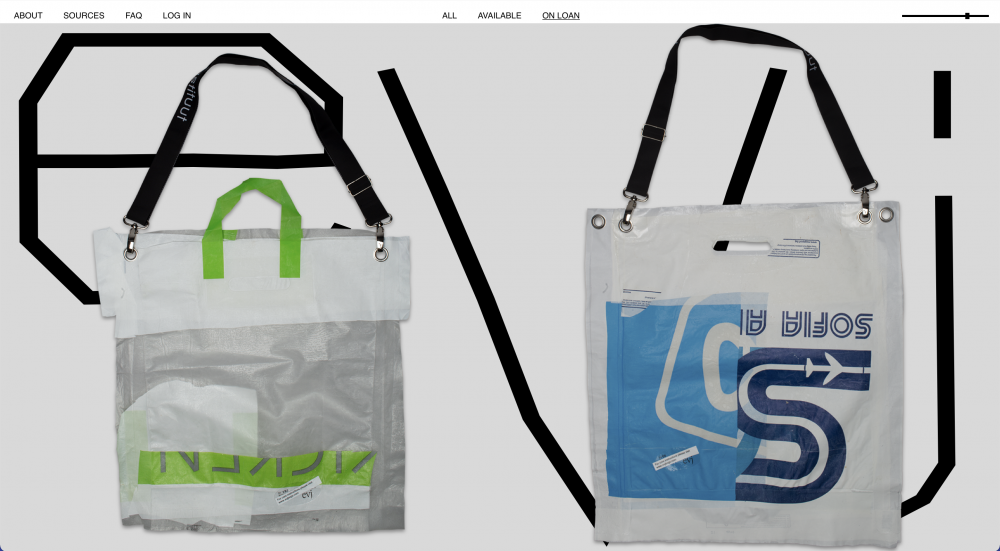
Beckers assisted Van Joolen in EVJ, as she has done in other projects: from 2018 till this summer, she was her assistant. Beckers and Van Joolen also collaborate on Warehouse, a fashion platform aimed at fostering critical discourse around clothing and design. And Van Joolen participated in Beckers’ project JOIN Collective Clothes, which has been ongoing since 2017. In JOIN, people create and wear clothes together: each participant makes a single piece of a garment – a sleeve, a top, a trouser-leg or part of a skirt – and these pieces can be combined and recombined at will. The resulting garments have no owners, or many owners at once: made by many and worn by many more, it’s hard to see them as anything other than a commons. Fashion is always a collective practice, Beckers says: but JOIN helps participants to actually experience and understand it as such, helping them question long-standing divisions between designers and makers, providers and users.
The projects differ in many ways, of course: bags are not the same as clothes, for one, and while EVJ is focused more heavily on value, ownership and care, JOIN is first and foremost about upending the division between maker and user, and allowing people to join in a collective act of creation. Even so, Van Joolen and Beckers share a preoccupation with the relationship between an object and its context, and both propose an alternative to the regular, capitalist market system of production and consumption. In the case of EVJ, that alternative system is one of circulation and care; in the case of JOIN, clothes are made and worn without money being exchanged, and without a clear hierarchy between the people involved.
What is more, both projects try to facilitate our insatiable desire for the new without bringing too many new things into the world. In the case of EVJ, the bags are made from used rather than raw materials, and people return them after eight months, a period Van Joolen chose deliberately, reasoning that most of us get bored with whatever it is we just bought after that length of time. Upon returning a bag, caretakers can select a new bag to take care of, allowing the thrill of the new without the waste of production. In the case of JOIN, new garments can be created time and again from the existing parts, allowing people to renew their wardrobe without having to buy something new.
Also, both projects encourage users to become active participants rather than passive consumers. EVJ turns users into caretakers, bestowing upon them a great responsibility as well as the experience of taking care of something that isn’t ours. JOIN lets participants partake in the creation of a garment, which helps raise awareness about the labor that goes into producing clothes while also giving people a sense of agency: ‘It can be a really nice feeling to actually make something, especially for people who don’t do so on a daily basis,’ Beckers says.
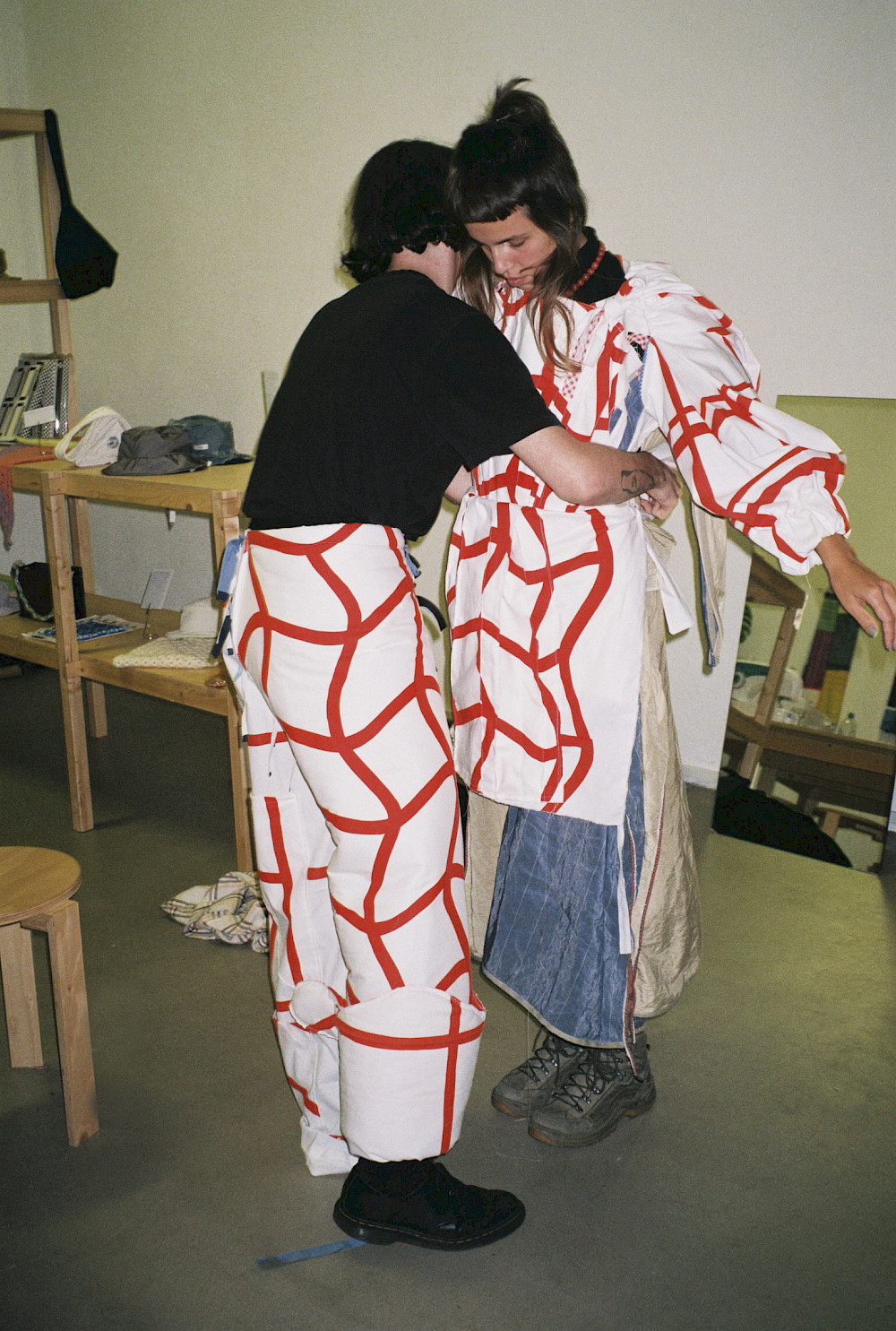
Most importantly, both the EVJ-bags and the garment-items in JOIN serve as a starting point for conversation. That conversation is about the way we normally experience and understand fashion, and what might be obscured in the process. The objects matter, of course, but they can’t be separated from their wider contexts: they are tools for criticism as much as they are tools for transportation (the EVJ-bags) or bodily protection (the JOIN-garments). And since what they critique are notions of individual ownership, originality, and monetary gain, stressing collaboration, the commons, and care instead, it only makes sense that as designers, Van Joolen and Beckers favor a fluid and open form of cooperation as well.
Van Joolen and Beckers met in 2013, when Beckers was a first-year student and Van Joolen her teacher. ‘I was working on a project, and Elisa came up with all these references. That’s when I realised: here is someone who understands what I’m doing, even while I don’t quite understand that yet myself,’ Beckers says. That project, much like JOIN, consisted of several students contributing their own piece to a final garment, like ingredients to a dish. The project was about the parts that make up a whole, and what happens when these parts are made interchangeable, modular.
Van Joolen, who by then had spent years questioning notions of ownership and originality in clothing and design, got what Beckers and her classmates were up to: in her own work, she had cut up and recombined pieces of brand-name clothes, creating new garments for which it was impossible to tell who was the creator – and thus owner – of these clothes (11x17). She’d also inverted sneakers to reveal the hand-stitched seams on the inside, making visible the labor that had gone into producing the shoes (Invert Footwear); and she had inked items of donated clothes and printed them on other pieces of clothing, making it impossible to distinguish the original from the copy (One-to-One).
During her studies, Beckers briefly interned with Elisa, before becoming her assistant in 2018 (‘I’m not a fan of the unpaid internship; I’d rather pay someone a proper wage to help me,’ Van Joolen says). Since then, they spent many Tuesdays together in Van Joolen’s studio, while on Fridays they usually meet elsewhere to work, with others, on Warehouse.
Their projects involve a great deal of openness and cooperation: EVJ and JOIN couldn’t exist without the active participation of the caretakers, creators and wearers. ‘My work is based on the belief that nothing ever exists in a vacuum,’ Beckers says: ‘Ideas are just a collection of fragments that you’ve picked up elsewhere. It feels strange to me, therefore, to claim something as ‘mine’. And once you see the world in this way, it’s only natural to work in a way that is collaborative and collective, rather than by yourself.’
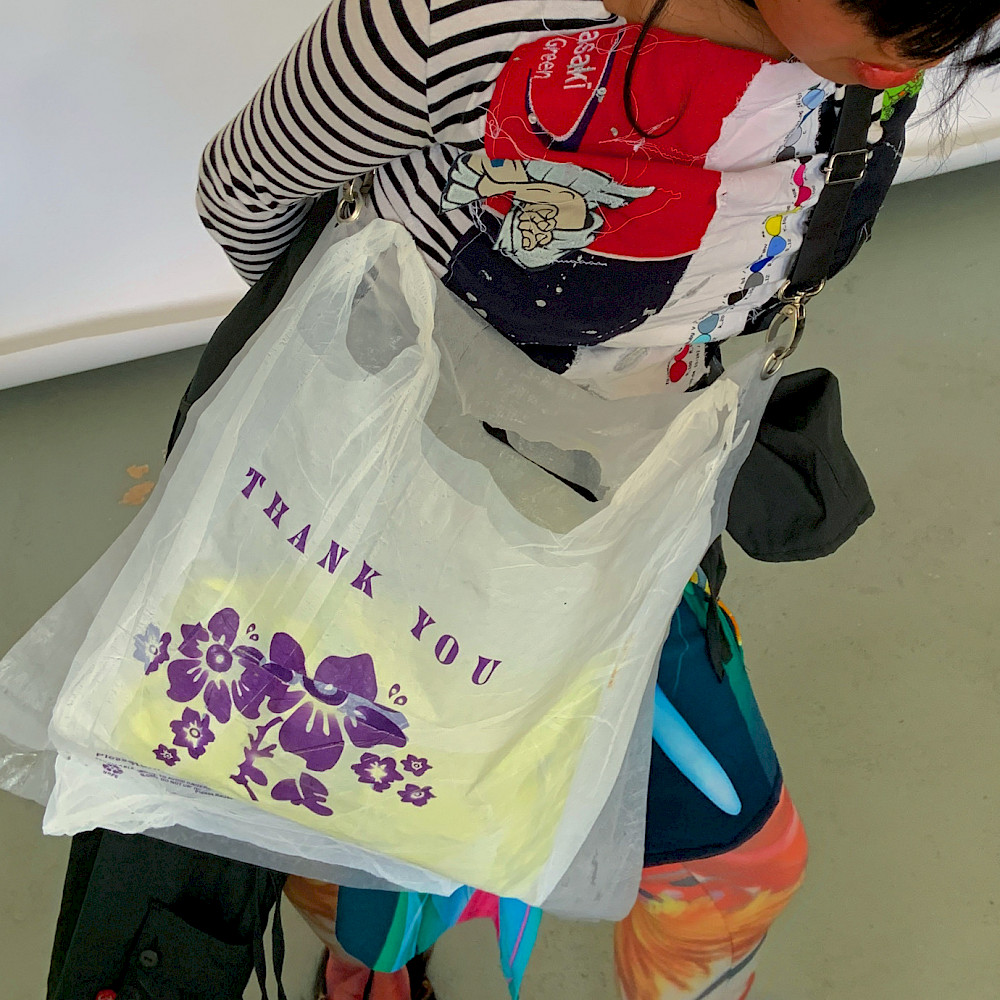
‘I recall reading Being Singular Plural by Jean Luc Nancy, and something clicked,’ Van Joolen adds. ‘It showed that there is just no way you can be singular in the world. The teacup needs a table to sit on, the table needs the floor to stand on, the floor needs a foundation and so on. We’re always connected to so many other things, and the things we design are always connected to so many other things. When you take that realization as a starting point, the only way to work is together with others. Besides: my designs are meant to raise questions – questions I couldn’t possibly answer all by myself.’
A firm belief in the importance of the collective doesn’t absolve the designer from playing a key part, however. The EVJ-bags belong to no one in particular,’ Van Joolen says, and the project serves as an exercise in creating and maintaining a commons: a place to which everybody contributes and which everybody can enjoy, but which no one can claim as theirs. But the infrastructure that’s required to allow that commons to function is maintained by Van Joolen: ‘People will contact me because their bag never arrived, or it did but it was the wrong one, and they’d like to return it. I constantly have to take care of it – which is also great, because it means I get to interact with all these people and learn how they relate to the bags. The other day I met up with a friend who has a bag that he was supposed to return months ago, but he just couldn’t get himself to do so, he’d grown attached to it. I told him I believed he’ll get there, at some point.’ Creating a new system, it turns out, means taking care of that system as well.
Beckers: ‘I’d like JOIN to be a place where there’s no hierarchy between creators, makers and users. Ideally, there would be no leader at all. But in the end, I’m the one responsible for making sure this project keeps functioning. Early on, I held a workshop with GRA students in which they all created a piece of garment. I figured that they would just take their own creations home with them, but they collectively decided that I should keep them. They felt the pieces had no meaning if they weren’t together. Now, I’m not sure if that’s true, but it was interesting that this was how they felt. So now I’m taking care of all these pieces, and deciding which ones to put on display during exhibitions. I’m all for freedom and collaboration, but some things you just can’t let go: in the end, you are responsible.’
By default, both EVJ and JOIN are open-ended. There’s no way of knowing, after all, how many caretakers will document the lives of their bags, as EVJ asks them to do, and how many will return the bags after the stipulated period. The meaning of the project will be determined in large part by these unpredictable outcomes. ‘People all bring their own experiences, thoughts and beliefs to this project,’ Van Joolen says: ‘sometimes that’s annoying, but most of the time it’s really interesting.’ It does mean, however, that ‘control’ becomes another dustheap notion.
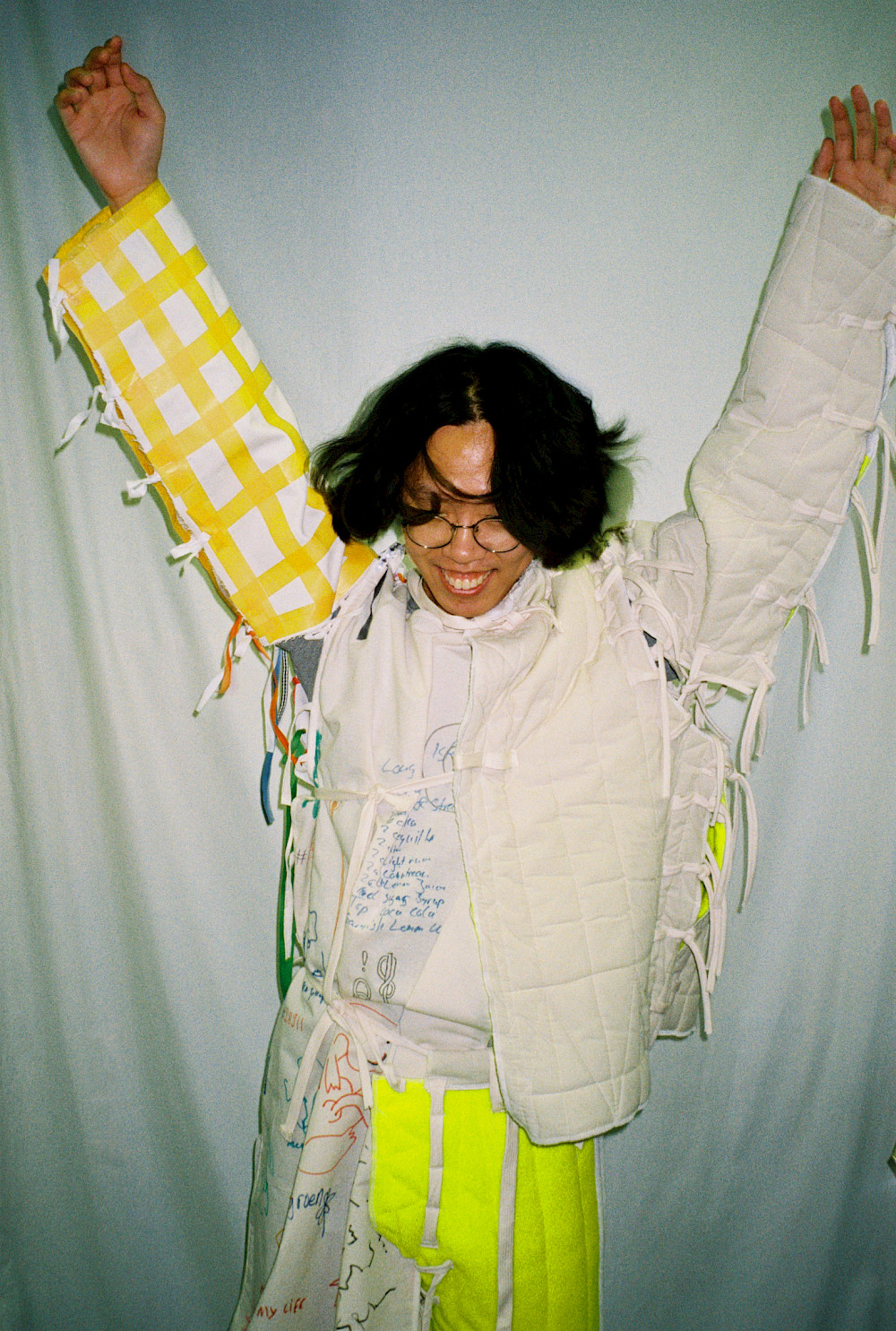
JOIN, too, is ever-evolving, as more participants join in and Beckers tries to figure out what kind of system would be needed in order for it to be scaled up even further. ‘So far, the clothes may be a bit too experimental for lots of people to wear in everyday life. I’ve thought about making a simple black or white coat that people can use as a base, exchanging sleeves with their neighbors. But would these items be for sale? Should I give them away? I don’t know that yet. It’s not my goal to create products, but I would like this method, this philosophy, to be worn by more people.’
Collectivity, Van Joolen says, resides not only in their approach to design and in the designs themselves; it’s also a larger feature of the larger design world around them. ‘When I started with 11x17 ten years ago, I had a hard time making myself understood. I was doing an MFA at Parsons, in New York, and most fashion students were still working in this cut-throat, competitive vein, fully focused on creating their own ‘unique’ designs and afraid that others might ‘steal’ those. Right now, though, I see a lot of projects that have similar, questioning and collective approach to my own work, here in the Netherlands but also in places like Norway, France and Australia. We’re all aware of each other’s work and encourage it; there’s a generosity that is crucial for this new, collective way of doing things.’
Closer to home, Beckers says, ‘Elisa and I can work together so well because we understand what the other is doing: when she told me about EVJ, I got the project immediately’ – just as Van Joolen immediately understood Becker’s research project when she was a first-year student. ‘And although there are family resemblances in our projects, it never feels like we’re getting in each other’s way,’ she says.
Van Joolen: ‘We’re not competitive, and this is a spirit I see growing among students now. They’re also much more interested in collaboration, and much more critical of existing, mainstream systems. Which is great, because real change starts there: with not accepting the status quo and coming up with an alternative instead.’
After all, Beckers adds, changing the system will always require collective action: ‘no one has ever changed a system on their own.’ With EVJ and JOIN, as well as their other past and future projects, Van Joolen and Beckers hope to offer starting points for such change: spaces in which people can become aware of and reflect on the costs of doing things as they are, and in which they can practice doing things differently.
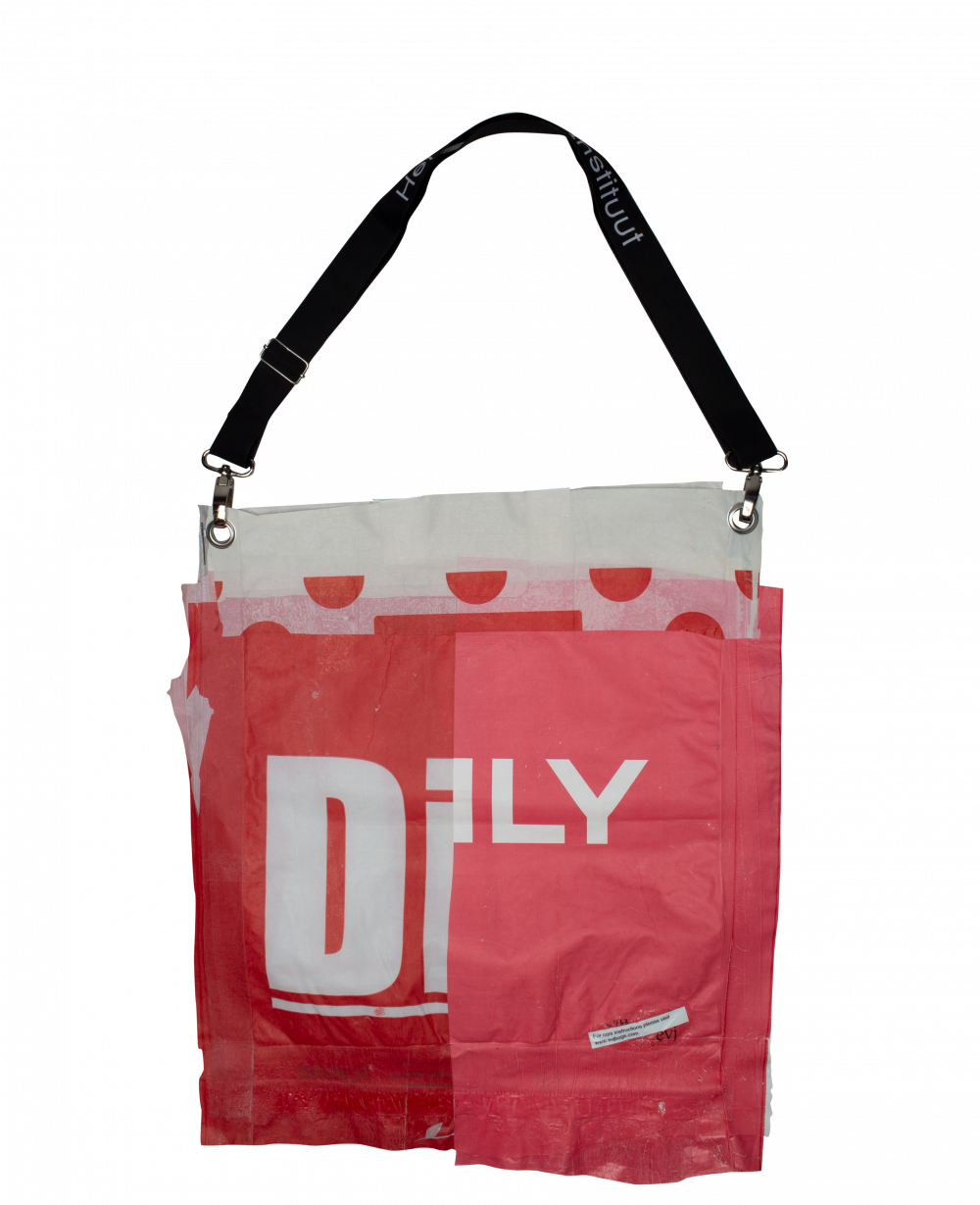
This publication is commissioned by the Editorial Board as part of the series 'Future Practices'
'Future Practices' is the framework for a series of publications on current topics that stimulate or question intercurricular education at the Gerrit Rietveld Academie. Various interdepartmental or interdisciplinary duos and teams have been asked to create a contribution in a format of their choice, such as a podcast, a text or an audiopiece. These collaborations originate in the first Open Call for Intercurricular Programmes in November 2020. Because of the many promising proposals, the editorial board decided to select 6 collaborations and asked these to publish their research via extraintra.nl in 2021.